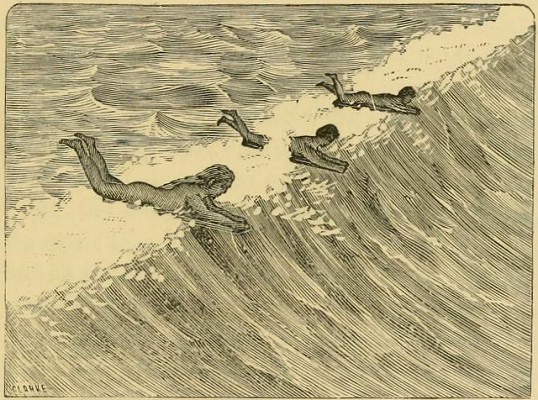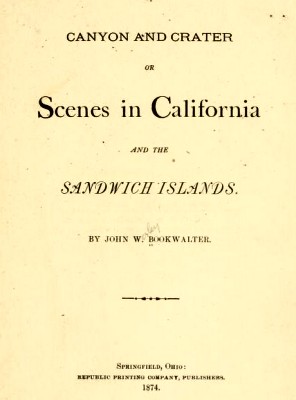
bookwalter : waikiki, 1874
| home | catalogue | history | references | appendix |
 |
surfresearch.com.au
bookwalter : waikiki, 1874 |
Internet
Archive
http://archive.org/details/canyoncraterorsc00book
At Waikiki,
some
three miles from the city, is a very pleasant bathing place.
It was the
sea
side resort of "Kamehameha Fifth."
As this
royal
Kanaka kicked the beam at something over 400 pounds, it
became a matter
of much concern as to how all this royal substance could be
transported
with the least discomfort to his ponderous majesty.
To this
circumstance
the tourist is indebted for the privilege of reaching
Waikiki by a pleasant
drive over one of the finest roads I ever met with.
It ought to
be
good, for it is about the only road in the entire kingdom.
Inter-transportation
is
effected in all the islands by ponies and donkeys.
The surf
here
is fine and as the water is deliciously warm, bathing
becomes here a luxury
indeed.
I saw at
this
place for the first time, that famous sport of the natives,
"surf bathing."
As the
Pacific
Ocean has here an uninterrupted sweep from the south of
several thousand
miles, the swells roll in with pro-
Page 180
digious
force,
dashing the water into immense snowy fleeces.
The native
takes
a small plank a foot wide and a few feet long, and by
adroitly diving under
the approaching waves, at length
works his
way
far out to sea.
Watching his
opportunity on the approach of an unusually heavy surf, he
dextrously flings
himself into it a little forward of the crest, slightly
inclines the board
to receive the forward impulse of the water, and with the
speed of the
wind rushes toward the shore, enveloped in a fleecy foam and
spray.
I did not
try
my hand at it, as I learned that to succeed required long
years of practice,
and it is rare to find, even among the
resident
whites,
one who is equal to the feat.
It is the
most
exciting sport I ever witnessed.
In the
distance,
projecting its clear, well cut, serrated edge against the
blue sky, rises
an isolated peak called Diamond Point.
It is a long
since extinct volcano, about one thousand feet in hight,
having in its
summit what is said to be the most symmetrical crater in the
islands, forming
a regular, almost circular cavity, like a huge punch-bowl.
I had while at Waikiki an opportunity of more carefully inspecting the canoes of the natives, which I had so often seen at a distance, dancing with their sable crews like mere dark specks on
Page 181

VIEW OF
WAIKIKI
AND DIAMOND POINT
Page 183
the snowy
crest
of the waves.
They are
constructed
mostly out of a very firm hard wood called '* Koa," and
sometimes of a
wood closely resembling it, called the "Kou."
They are of
extreme
length as compared with the width, so narrow in fact that a
man of good
proportions would have to limit himself to a very frugal
dinner if he preferred
to sit down, rather than be compelled to stand up like a
"Colossus of Rhodes
" in one of them.
They would
be
no doubt completely unmanageable, were it not for a device
employed on
all the canoes of the South Seas, which is called an
out-rigger.
Springing
from
one side of the boat are two long curved pieces of wood, one
end being
lashed to the canoe by a kind of cordage made from the
fibres of the Lauhalla,
and the other just dipping
beneath the
surface
of the water. Connecting
these two
pieces
at their ends, and lashed in a similar way is a piece of
very light, porous
wood called " will will," which floats upon the surface of
the water at
a distance of about ten feet from the side of the boat,
adding greatly
to its stability.
Even with this addition, it is yet unfit to be used for purposes of navigation by any less skillful gymnast than a Blondin, for I am certain an ordinary man would feel quite as safe and comforta-
Page 184
ble, and
would
have no greater difficulty in preserving his balance, were
he to attempt
to navigate the Atlantic in a butter-bowl.
Yet the bold
manner in which the natives plunge out into the roughest
seas, and the
skill with which they manage these light, treacherous craft,
even in a
raging surf, is a marvel to behold.
In fitting
out
a fleet for warlike purposes, it was once their custom, in
former times,
to lash quite a number of these canoes together, side by
side, rendering
outriggers unnecessary, and thus forming a kind of compound
boat, of considerable
capacity and quite serviceable.
It is said
that
Kamehameha 1st made his tour of conquest among these islands
in boats constructed
in the manner described.
Page 185

 |
Canyon and Crater; or, Scenes in California and the Sandwich Islands. Republic Printing Company, Springfield, Ohio, 1874. Internet Archive http://archive.org/details/canyoncraterorsc00book |

| home | catalogue | history | references | appendix |